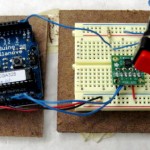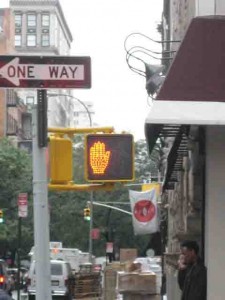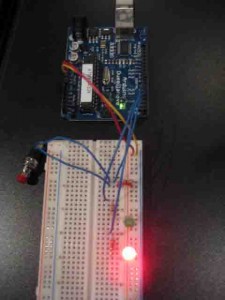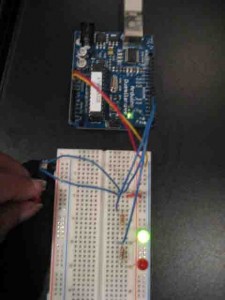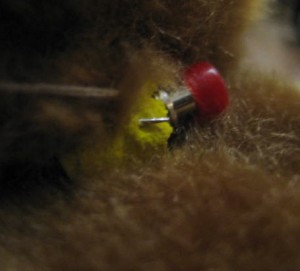Introduction: The idea behind this post was to describe how I attempted to use a wave shield to play a sound using a photocell as the trigger.
Description: Just for the record, the code for the wave shield is really confusing, but I have gotten it to work – though that was a painful process. After about 45-60 minutes, it became apparent that the problem I had with playing the .wav files on the SD card was due to the SD card being formatted as FAT 12, not FAT 16. Then at least another 30 minutes was spent trying to find a Windows computer to reformat the card. (We don’t have authority on the computer lab PCs.)
Now, it plays “ominous noise” and the intro to BBC America news.
For my next trick, what I’d like to do is to put this code inside the loop for the LED-shadow sketch.
#include <AF_Wave.h>
#include <avr/pgmspace.h>
#include "util.h"
#include "wave.h"
AF_Wave card;
File f;
Wavefile wave; // only one!
#define redled 9
uint16_t samplerate;
void setup() {
Serial.begin(9600); // set up Serial library at 9600 bps
Serial.println("Wave test!");
pinMode(2, OUTPUT);
pinMode(3, OUTPUT);
pinMode(4, OUTPUT);
pinMode(5, OUTPUT);
pinMode(redled, OUTPUT);
if (!card.init_card()) {
putstring_nl("Card init. failed!"); return;
}
if (!card.open_partition()) {
putstring_nl("No partition!"); return;
}
if (!card.open_filesys()) {
putstring_nl("Couldn't open filesys"); return;
}
if (!card.open_rootdir()) {
putstring_nl("Couldn't open dir"); return;
}
putstring_nl("Files found:");
ls();
}
void ls() {
char name[13];
int ret;
card.reset_dir();
putstring_nl("Files found:");
while (1) {
ret = card.get_next_name_in_dir(name);
if (!ret) {
card.reset_dir();
return;
}
Serial.println(name);
}
}
uint8_t tracknum = 0;
void loop() {
uint8_t i, r;
char c, name[15];
card.reset_dir();
// scroll through the files in the directory
for (i=0; i<tracknum+1; i++) {
r = card.get_next_name_in_dir(name);
if (!r) {
// ran out of tracks! start over
tracknum = 0;
return;
}
}
putstring("\n\rPlaying "); Serial.print(name);
// reset the directory so we can find the file
card.reset_dir();
playcomplete(name);
tracknum++;
}
void playcomplete(char *name) {
uint16_t potval;
uint32_t newsamplerate;
playfile(name);
samplerate = wave.dwSamplesPerSec;
while (wave.isplaying) {
// you can do stuff here!
delay(500);
}
card.close_file(f);
}
void playfile(char *name) {
f = card.open_file(name);
if (!f) {
putstring_nl(" Couldn't open file"); return;
}
if (!wave.create(f)) {
putstring_nl(" Not a valid WAV"); return;
}
// ok time to play!
wave.play();
}
Considering how strung out I feel regarding finishing my finals before I head to London, I hope to make it alive through this particular process. It seems doubtful.
